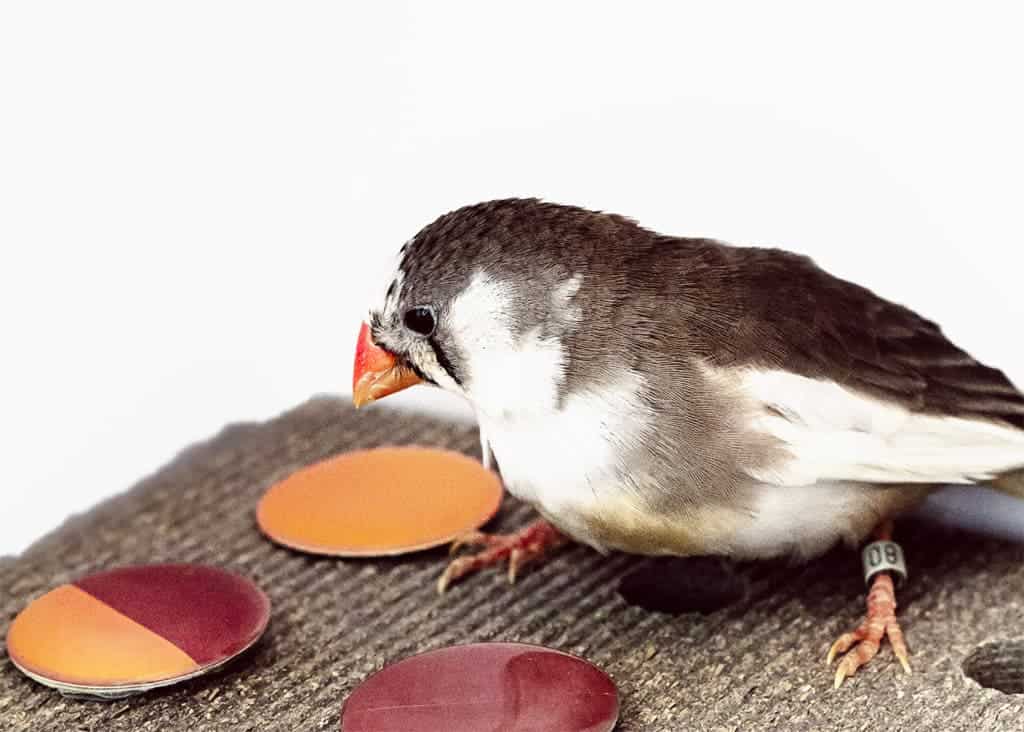Zebra finches seem to clump similar hues together and perceive them as single colors, new research suggests. This approach is similar to how the human mind processes color and sheds light on the biological root of color perception.

Zebra finches break the color spectrum into discrete colors — much like we do.
Image credits Ryan Huang / TerraCommunications LLC
For zebra finch (Taeniopygia guttata) males, wooing is all about what colors you’re wearing. These gents sport various hues on their beaks, ranging from light orange to dark red, which they use to attract mates. But all their chromatic efforts might be in vain, new research suggests, as the females may simply not perceive subtle nuances.
Red is red
For the study, the researchers worked with 26 zebra finch females and a handful of paper discs the size of a small coin. Some of these discs were painted in a solid color, while others were two-toned. The birds were taught that flipping over a two-toned disc earns them a reward in the form of a millet seed hidden beneath it. Solid-colored discs, meanwhile, didn’t return any tasty treats.
What the team wanted to determine through this experiment was how well the zebra finches could perceive ranges of hues. A bird picking at a certain disk before others during the experiment indicated that it perceived it as being two-toned, i.e. that it could perceive the hues on the disk as being different from one another. To see exactly how well the birds could distinguish different hues, some trials involved discs painted in color pairs that were far apart on the color spectrum (violet and yellow would be such a combination) while others used colors that were more similar (red-orange, for example).
Perhaps unsurprisingly, the females found it a breeze to perceive pairings of dissimilar colors. However, they didn’t fare nearly as well when trying to discern pairings of the hues in between these colors. The findings suggest a threshold effect at work — a sharp perceptual boundary near the orange-red transition.
The birds were also much better at spotting a two-toned disc if it bore colors from the opposite sides of the boundary (i.e. red-orange, for example) than pairs from the same side (two shades of the same color). This effect persisted even when the pairs were all equally far apart on the color spectrum, the team notes. This suggests that, while the finches have no problem perceiving different colors side-by-side, they do have some difficulty perceiving different hues of the same color on the discs.
First off, the findings help us gain a better understanding of how zebra finches handle romance. Previous research has shown that red-beaked males have more success with the ladies, likely because the color denotes good health. While this present study doesn’t show whether the females prefer one color over another, it does help us understand what females perceive when looking at potential mates.
The findings indicate that the birds lump all hues of red on one side of a certain threshold as being ‘red’. Because of this, the females likely aren’t very picky.
“What we’re showing is: he’s either red enough or not,” said senior author Stephen Nowicki, a biology professor at the Duke University.
It also helps us gain a better understanding of our own vision. The process of lumping similar hues together and perceiving them as a single color, known as categorical color perception, is something that our brain does as well. It’s not yet clear whether we share the same orange-red threshold with zebra finches, but the fact that we both exhibit categorical color perception suggests that the process has deep biological roots. Color, then, might not be just a construct of human language and culture, but may also stem from biological hardwiring.
Still, it likely doesn’t happen in the eye, the team writes — categorical color perception, even in zebra finches, is probably a product of their minds.
We don’t ‘see’ the light that hits our retina; what we see is the image our brain constructs from that data. This type of color perception, then, could be a way for the brain to help reduce ambiguity and noise from the environment — a way for our lumps of gray matter to help keep images simple so we don’t get overwhelmed.
“We’re taking in this barrage of information, and our brain is creating a reality that is not real,” said senior author Stephen Nowicki.
“Categorical perception — what we show in zebra finches — is perhaps one strategy the brain has for reducing this ambiguity,” adds Duke postdoctoral associate and paper co-author Eleanor Caves. “Categories make it less crucial that you precisely interpret a stimulus; rather, you just need to interpret the category that it’s in.”
The paper “Categorical Perception of Colour Signals in a Songbird” has been published in the journal Nature.










